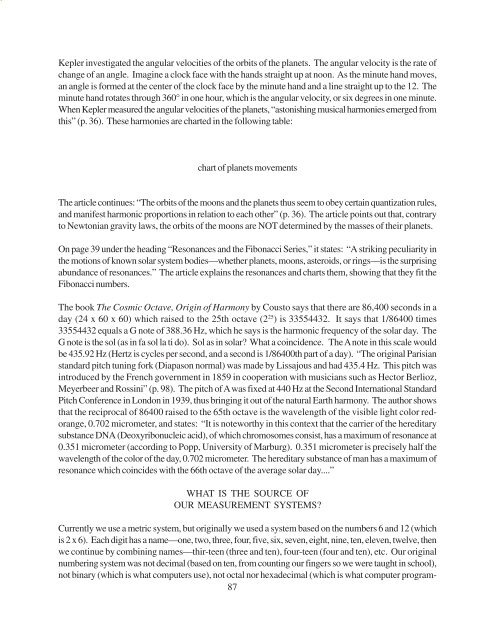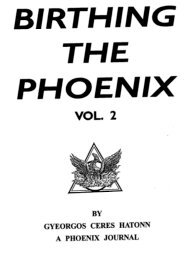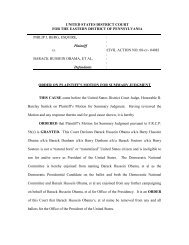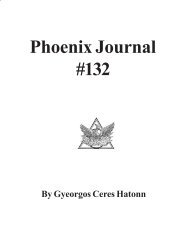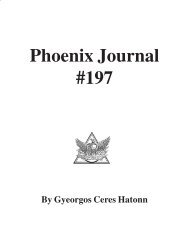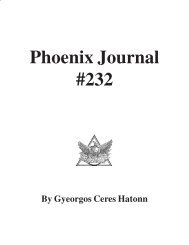Phoenix Journal 208 - Four Winds 10
Phoenix Journal 208 - Four Winds 10
Phoenix Journal 208 - Four Winds 10
You also want an ePaper? Increase the reach of your titles
YUMPU automatically turns print PDFs into web optimized ePapers that Google loves.
Kepler investigated the angular velocities of the orbits of the planets. The angular velocity is the rate of<br />
change of an angle. Imagine a clock face with the hands straight up at noon. As the minute hand moves,<br />
an angle is formed at the center of the clock face by the minute hand and a line straight up to the 12. The<br />
minute hand rotates through 360° in one hour, which is the angular velocity, or six degrees in one minute.<br />
When Kepler measured the angular velocities of the planets, “astonishing musical harmonies emerged from<br />
this” (p. 36). These harmonies are charted in the following table:<br />
chart of planets movements<br />
The article continues: “The orbits of the moons and the planets thus seem to obey certain quantization rules,<br />
and manifest harmonic proportions in relation to each other” (p. 36). The article points out that, contrary<br />
to Newtonian gravity laws, the orbits of the moons are NOT determined by the masses of their planets.<br />
On page 39 under the heading “Resonances and the Fibonacci Series,” it states: “A striking peculiarity in<br />
the motions of known solar system bodies—whether planets, moons, asteroids, or rings—is the surprising<br />
abundance of resonances.” The article explains the resonances and charts them, showing that they fit the<br />
Fibonacci numbers.<br />
The book The Cosmic Octave, Origin of Harmony by Cousto says that there are 86,400 seconds in a<br />
day (24 x 60 x 60) which raised to the 25th octave (2 25 ) is 33554432. It says that 1/86400 times<br />
33554432 equals a G note of 388.36 Hz, which he says is the harmonic frequency of the solar day. The<br />
G note is the sol (as in fa sol la ti do). Sol as in solar? What a coincidence. The A note in this scale would<br />
be 435.92 Hz (Hertz is cycles per second, and a second is 1/86400th part of a day). “The original Parisian<br />
standard pitch tuning fork (Diapason normal) was made by Lissajous and had 435.4 Hz. This pitch was<br />
introduced by the French government in 1859 in cooperation with musicians such as Hector Berlioz,<br />
Meyerbeer and Rossini” (p. 98). The pitch of A was fixed at 440 Hz at the Second International Standard<br />
Pitch Conference in London in 1939, thus bringing it out of the natural Earth harmony. The author shows<br />
that the reciprocal of 86400 raised to the 65th octave is the wavelength of the visible light color redorange,<br />
0.702 micrometer, and states: “It is noteworthy in this context that the carrier of the hereditary<br />
substance DNA (Deoxyribonucleic acid), of which chromosomes consist, has a maximum of resonance at<br />
0.351 micrometer (according to Popp, University of Marburg). 0.351 micrometer is precisely half the<br />
wavelength of the color of the day, 0.702 micrometer. The hereditary substance of man has a maximum of<br />
resonance which coincides with the 66th octave of the average solar day....”<br />
WHAT IS THE SOURCE OF<br />
OUR MEASUREMENT SYSTEMS?<br />
Currently we use a metric system, but originally we used a system based on the numbers 6 and 12 (which<br />
is 2 x 6). Each digit has a name—one, two, three, four, five, six, seven, eight, nine, ten, eleven, twelve, then<br />
we continue by combining names—thir-teen (three and ten), four-teen (four and ten), etc. Our original<br />
numbering system was not decimal (based on ten, from counting our fingers so we were taught in school),<br />
not binary (which is what computers use), not octal nor hexadecimal (which is what computer program-<br />
87


